Phoenix Server Install Guide
This guide will assist you with installing Phoenix Server. Phoenix is the latest version of the Voice Solutions server product line, providing a complete dictation and transcription solution. If you need assistance with product configuration or features, see the Phoenix Server User Guide.
Skip down to:
System Requirements
Installing Server Core Software
Installing Telephony Cards
Installing Additional Features
Configuring Windows
Product Activation
Connecting Phone Lines
Minimum System Requirements
Operating System
Microsoft Windows 2008 Server R2 (32-bit & 64-bit)
Microsoft Windows 2012
Microsoft Windows 7 (32-bit & 64-bit)
Microsoft Windows 8 (32-bit & 64-bit)
Hardware
Dual-Core processor
2 GB RAM
50 GB of available hard disk space
PCI slot or USB port (if using the telephony feature)
1024 x 768 resolution with 16-bit color (for Phoenix Navigator)
Virtual Environment Supported: Yes
Recommended System Requirements
Operating System
Microsoft Windows 7 (64-bit)
Microsoft Windows 2012 Server (NOTE: There are no benefits to running Phoenix Server on Windows Server, as Phoenix should be on a dedicated system, not a Domain Controller, DNS server, etc. So Windows 7 is the ideal OS.)
Hardware
Quad-Core processor
4 GB RAM
200 GB of available hard disk space
PCI slot(s) (if using the telephony feature)
1024 x 768 resolution with 16-bit color (for Phoenix Navigator)
Virtual Environment Supported: Yes
Installing Server Core Software
Step 1: Disable Windows' User Account Control (UAC) and then reboot. UAC can be managed from the Users Control Panel. UAC cannot be enabled at any time for all Phoenix Server functions to work properly
Step 2 (on Windows Server 2008, Server 2012, and Windows 8): The .NET 3.5 framework must be installed. This can be done one of two ways (except with Windows 8 which can only use method 2).
-
Method 1 - Server Manager (Server 2008 only)
From Server Manager go to Features and click the Add Features option. Expand the .NET 3.5.1 Features option and check the box for .NET Framework 3.5.1. Click Next and then click Install.
Method 1 - Server Manager (Server 2012 only):
From Server Manager click Add roles and features. From the new window select your Installation Type and the click on the Features tab. Expand the .NET Framework 3.5 Features option and check the box for .NET Framework 3.5 (includes .NET 2.0 and 3.0). Click Next and then click Install.
Method 2 - Powershell/Command Prompt:
Right-click the Powershell or Command Prompt shortcut and choose Run as administrator when starting. Now insert your Windows Installation disc and then type or paste into Powershell/Command Prompt:
dism /online /enable-feature /featurename:NetFX3 /all /Source:d:\sources\sxs /LimitAccess
NOTE: Source:d references your disc drive. So if it is not letter d, then replace d with the correct drive letter. The .NET framework should now install.
Step 3: Temporarily disable any anti-virus or anti-spyware software to prevent conflicts during the installation.
Step 4: Insert the installation CD. From the main screen select Install Phoenix Server.

Step 5: The installer will appear. Simply click Next to the first couple of screens.
• You will then be prompted to select the installation path (see image below). Unless there is a specific reason to install the software on a different drive letter, we recommend that you keep the default path of C:\VoiceSolutions. If you select a different drive letter as the destination, be sure to keep the VoiceSolutions directory (ex. D:\VoiceSolutions).
• Leave the option Everyone selected; do not select Just Me. When finished with this screen, click Next again until the installer starts.

Step 6: When the primary installer finishes, the System Finalizer application will automatically pop up (see image below). The install steps are numbered on this screen to help guide you in completing the installation process. Under the Essentials section, start by clicking the Install button under Step 1 to install the Navigator.

Step 5: The Phoenix Navigator installer is very simple - just click Next to all the prompts. The only option you may need to change is the Destination Folder (see image below). By default it is C:\VoiceSolutions\Navigator. You MUST install the application under the Phoenix Server's root. This is the path you set in Step 3. If you kept the default path in Step 3, then keep the default path here as well.

Step 6: Now that the Navigator is installed, under the Essentials section of the System Finalizer, click the Install button on Step 2 for VC Redistributable (see image below). Simply click Next to all prompts.

Step 7: Continuing with the steps under the Essentials section of the System Finalizer, click the Install button on Step 3 for SQLite ODBC. Click Next to all prompts until you reach Choose Components screen (see image below). Check the SQLite+TCC option and then click Install. If you do not check this option most of the Phoenix services will not be able to start.
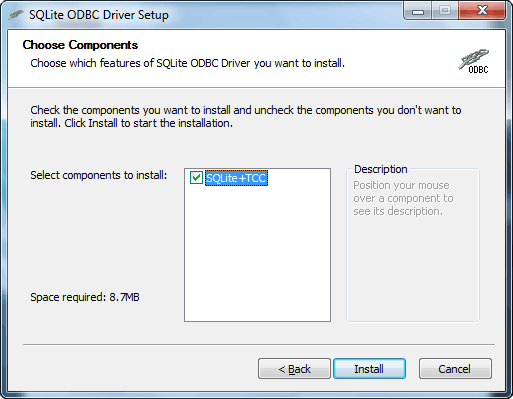
Step 8 (64-bit computers only): Continuing with the steps under the Essentials section of the System Finalizer, click the Install button on Step 4 for SQLite ODBC 64 bit (see image below). Simply click Next to all prompts.
NOTE: This option will only be available if you are installing on a 64-bit computer. If the computer is 32-bit this button will be grayed out and you should skip to the next step.
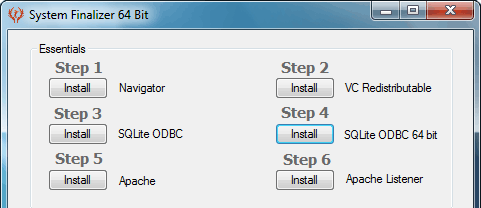
Step 9: Continuing with the steps under the Essentials section of the System Finalizer, click the Install button on Step 5 for Apache. Click Next to the prompts until you reach the Apache Server Information screen (see below).
• Enter your domain name in the Network Domain field. If you are not on a domain, then try entering your computer's name.
• The Server Name field should have the computer's name. It is VERY important that this be correct. If you plan on changing the computer's name, do so now before installing Apache (note: you will have to reboot for the name change to take effect).
• Enter a technical support email in the Administrator's Email Address field. This field is never used by Phoenix but it is recommended that the DAC dealer's support email address be entered.
• Keep the default option selected for All users, on Port 80, as a Service -- Recommended and click Next.
• You will be given a screen to choose Setup Type with the options of Typical and Custom. Keep the default option of Typical and click Next for the remaining prompts.
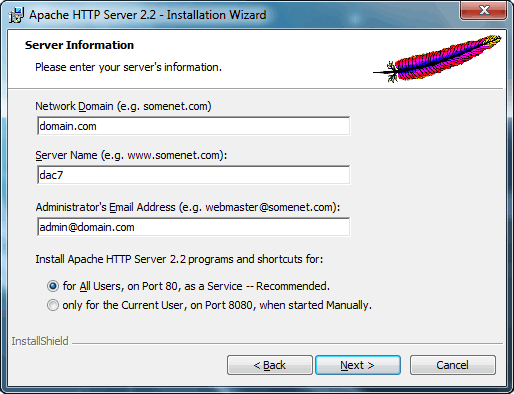
Step 10: Continuing with the steps under the Essentials section of the System Finalizer, click the Install button on Step 6 for Apache Listener . A command prompt screen may appear briefly (see image below). No action is required on your part.

Phoenix Server is now installed!
After rebooting, you should have the Apache2.2 service running. If you will be installing Telephony Cards or Additional Features, proceed on to those sections. If not, then be sure to follow the steps in the Configuring Windows and Product Activation sections.
Skip down to:
Installing Telephony Cards
Installing Additional Features
Configuring Windows
Product Activation
Installing Telephony Cards
You only need to follow these installation steps if you are adding a PCI or USB telephony card to the Phoenix Server. If you are using the USB option, it is recommended that you do not use a USB hub. If it is absolutely necessary, make sure the USB hub is a powered model (plugs into an outlet) to ensure the telephony card gets enough power.
Virtual Machine Installs
Phoenix Server can be installed on a virtual machine. Only a USB telephony card can be attached to a VM Phoenix Server. However, if running a VM cluster, then there is not currently a telephony option that can be added.
Step 1: Install your PCI telephony card or connect the USB cable to the server. Ignore any Windows New Hardware prompts that appear.
Step 2: Open the System Finalizer. By default this is located at C:\VoiceSolutions\Temp\System Install Finalizer\Install Finalizer.exe. Under the Telephony section, click the Install button for Synway Drivers (see image below). The Synway installer will open.
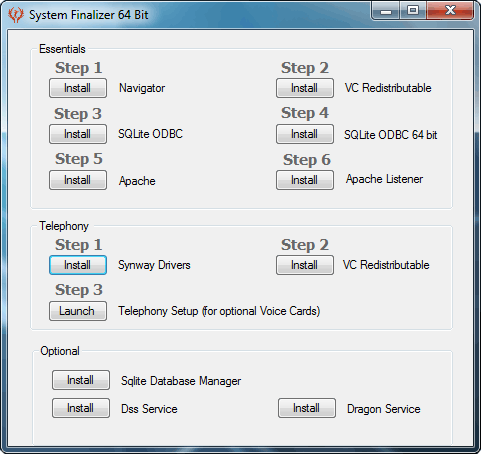
Step 3: Click Next to the prompts until you reach a screen asking you to Select Features. Click on Typical to continue.
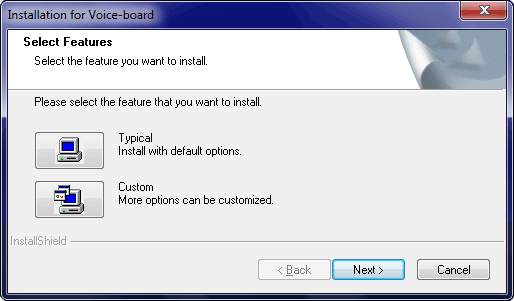
Step 4 (64-bit computers only): If you are installing on a 64-bit computer, you will be prompted to choose between 32-bit and 64-bit drivers. Select 32-bit mode and click Next. This is because although the computer is 64-bit, the telephony service runs in 32-bit mode.

Step 5: You may receive a Windows Security popup, warning you that "Windows can't verify the publisher of this driver sofware". Select Install this driver software anyway to proceed. When the driver installation finishes it should produce a small popup stating that the voice card(s) were installed successfully and list the serial number(s). The installer will close.

Step 6 (64-bit computers only): Continuing with the steps under the Telephony section of the System Finalizer click the Install button on Step 2 for VC Redistributable (see image below). Simply click Next to the prompts.
NOTE: If the computer is 32-bit this button will be grayed out and you should skip to the next step.

Step 7: Continuing with the steps under the Telephony section of the System Finalizer click the Launch button on Step 3 for Telephony Setup (see image below). This will open the System Telephony Setup application.

Step 8: Start by selecting what type of telephony card(s) you have installed. If you have multiple PCI cards, then select the total number of telephony ports it equals. For example, if you have two 8-port PCI cards, then select the 16 Port PCI option.
• Now enter the serial number for each telephony card, whether it be PCI or USB. The order does not matter and you do not have to enter leading zeros.
• Click Configure Voice Boards and Install Service. Click Exit when finished.

Step 9: To test your installation, open the Phoenix Navigator and start the Phoenix Recorder service. Initially, the Recorder button should be red (at the top right of the Navigator screen). Right-click it and select Start. The button should turn green after a few seconds. This means the Recorder service is now running and you can now plug in any phone lines.
NOTE: The first time the service is ran, Phoenix Server verifies that the telephony cards have valid DAC serial numbers. This requires that the server have an internet connection. Once verified and the service starts, the internet connection is no longer required.
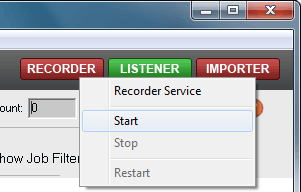
The telephony card installation is now complete!
At this point, you can proceed to install some Additional Features or skip to the Windows Configuration to get your Phoenix Server live.
Skip down to:
Installing Additional Features
Configuring Windows
Product Activation
Installing Additional Features (optional)
This section will walk you through installing five optional features: SQLite Database Manager, Dss Service, Dragon Service, iNet 3, and Dss Extractor Pro.
Skip down to:
SQLite Manager
Dss Service
Dragon Service
iNet 3
Dss Extractor Pro
SQLite Database Manager
This application will allow you to edit the Phoenix databases. It is extremely rare that you would ever need to do so and it is recommended that only a DAC technician or authorized DAC dealer make such changes as database corruption could result from any mistakes. You can install the manager by:
• Running the installer from the Phoenix Server Install CD or
• Open the Phoenix System Finalizer. Under the Optional section, click the Install button for SQLite Database Manager.
Simply keep the defaults and the installation is complete.
Dss Service
The Dss Service and codec is necessary in order to import dss audio files into the Phoenix Server. If you will not be importing dss files then you do not need to install this feature.
Step 1: First, install the Dss Service. To do this, open the System Finalizer. Under the Optional section, click the Install button for Dss Service (see image below).

You will receive a popup stating the installation was successful. The Windows service Phoenix DSS Converter is now installed. Click OK and you can quit the System Finalizer.
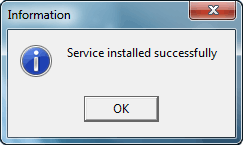
Step 2 (Windows Server 2008 only): The Desktop Experience feature needs to be installed. From Server Manager go to Features and click the Add Features option. Check the box for Desktop Experience and click Next and then Install.
Step 2 (Windows Server 2012 only): The Media Foundation and User Interfaces and Infrastructure features need to be installed. From Server Manager click Add roles and features. From the new window select your Installation Type and the click on the Features tab. Check the box for Media Foundation and User Interfaces and Infrastructure. Click Next and then click Install.
Step 3: Now you need to install the Dss codec. This is done by installing Olympus' Dss Player Pro. It is included on the Phoenix Server install CD. Simply keep the defaults during the installation. You will need to provide your own Product Registration Key.
• After Dss Player Pro is installed, launch the application and be sure to allow the automatic update to version 5.0.14 or higher to be downloaded. If you do not download this update then .dss files may not convert correctly.
Dragon Service
The Dragon Service is necessary in order to export audio files at a higher bitrate for Dragon NaturallySpeaking to convert them into text. If you will not be exporting to Dragon NaturallySpeaking then you do not need to install this feature.
Step 1: Install the Dragon Service. To do this, open the System Finalizer. Under the Optional section, click the Install button for Dragon Service (see image below).

You will receive a popup stating the installation was successful. The Windows service Phoenix 11k Converter is now installed. Click OK and you can quit the System Finalizer. The installation is complete!

iNet 3
iNet 3 is a transcription solution for Phoenix. In addition, it can be used to create detailed productivity reports from the server. If you do not need to create reports, or would like to run iNet 3 from a workstation instead, then you do not need to install this application.
Step 1: To install, simply run the installer from the Phoenix Server Install CD or from an iNet 3 Install CD.
Step 2: Keep all the defaults during the installation. By default iNet 3 will be looking for a server named dac7. You will need to change iNet 3's Server URL to match the Phoenix server's IP address or name (see the iNet 3 User Guide for more).
Dss Extractor Pro
Dss Extractor Pro allows you to download a digital voice recorder to be imported into the Phoenix server. If do not need to download a digital voice recorder, or will do so from another computer, then you do not need to install this application.
Step 1: To install, simply run the installer from the Phoenix Server Install CD or from an iNet 3 Install CD.
Step 2: Keep all the defaults during the installation. Once installed, set the Destination Folder (where the files where will be downloaded to) for each portable type to C:\VoiceSolutions\Import. If you installed the VoiceSolutions directory on a different drive letter, then replace C: with the correct driver letter (see the Dss Extractor Pro User Guide for more).
NOTE: This Destination Folder will be changed to a network path when Dss Extractor Pro is installed on other workstations.
It's time to Configure Windows and do the Product Activation now!
Skip down to:
Configuring Windows
Product Activation
Configuring Windows
This section will walk you through sharing the VoiceSolutions directory, opening ports in your firewall, and making exceptions in your security software.
Skip down to:
Creating a Network Share
Firewall Configuration
Security Software Exceptions
Creating a Network Share
The VoiceSolutions root (by default: C:\VoiceSolutions) must be shared for these features to work:
• Phoenix Navigator to run on a remote workstation for administration
If you will not be using the above features, the VoiceSolutions root does not have to be shared. Follow these guidelines when creating the share:
• Grant Full Control to the User or Group that will need to access the share
• If you want the share to be hidden, you can optionally add the dollar sign ($) after the share name when you create the network share (ex. voicesolutions$)
The Import folder (by default: C:\VoiceSolutions\Import) must be shared for these features to work:
• Dss Extractor Pro to upload audio files using the network path instead of the HTTP(S) upload feature
• Importing audio files manually from a network connection
If you will not be using the above features, the Import folder does not have to be shared, although it is recommended. If the VoiceSolutions root is already shared, then the Import folder will also be accessible as it is located in the VoiceSolutions root. However, it is not recommended that you provide access to the Import folder in this way, as it allows users to access Phoenix system files and its database. Follow these guidelines when creating the share:
• Grant Full Control to the User or Group that will need to access the share
What we recommend: From a security standpoint, it is not wise to share the VoiceSolutions root unless it is a hidden share. This is because anyone browsing to the server could then easily access or delete audio or database files, causing not only a security breach but perhaps a Phoenix Server crash. Granted, a hidden share is still accessible but would require that the user enter the exact path, including $ sign, which is far less likely. In addition, permission to this share can be restricted only to the user(s) that will have Phoenix Navigator. Alternatively, if you will not be running Phoenix Navigator on a remote workstation, you could share the Import folder in place of the VoiceSolutions root. This is located at VoiceSolutions\Import. Sharing this folder will allow for remote audio files to be imported from network sources, and since there is not any content inside the Import folder (as files are imported instantly) then all security and stability issues are resolved regardless of who has access to this share.
Firewall Configuration
For iNet 3 to connect to Phoenix Server and Dss Extractor Pro to use the HTTP(S) upload feature, you will need to open the HTTP(S) ports on both Phoenix Server and network firewalls. Since there are a variety of firewall software solutions out there please refer to that product's documentation for assistance. iNet 3 and Dss Extractor Pro are actually dependent on what the Apache Web Server service is configured to run on. So the port numbers are technically for Apache. Here are some tips:
• By default the Phoenix Server installer assigns port 3333 (HTTP) and 4444 (HTTPS)
• If you change the HTTP or HTTPS ports that Apahce Web Server is using, be sure to open those new port numbers in your firewall
• The local firewall on Phoenix Server only needs to have the HTTP and HTTPS ports opened for incoming connections, not outgoing
Security Software Exceptions
There are a variety of anti-virus, anti-malware, and other security software products available. It is highly recommended that you make the VoiceSolutions root (by default: C:\VoiceSolutions) an exception in all such security applications. Some reasons are:
• Dictation files could be quarantined or purged, resulting in lost data
• Vital Phoenix application files could be quarantined or purged, resulting in complete system failure
Product Activation
Activating the Phoenix Server software allows the Phoenix File Manager service to run. Without this service running (shown as the Import button in Phoenix Navigator), audio files cannot be imported. Activation is simple.
Step 1: Open Phoenix Navigator from the server and from the main menu go to Help>System Information.
Step 2: The Phoenix System Information screen will pop up. If Phoenix Server is not activated you will have Register System in bold red text at the bottom-right corner of the pop up. Click it to see more options.
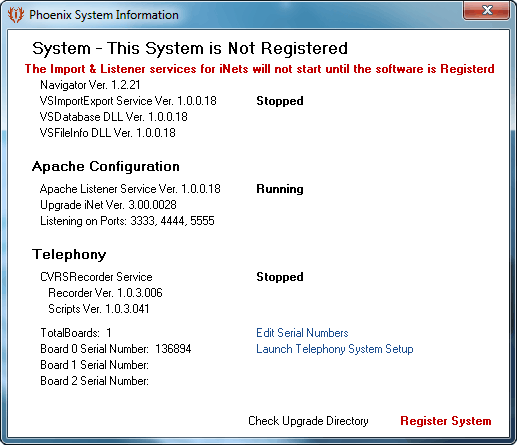
Step 3: You will need to provide us the Registration Code. You can do this by email or phone during regular business hours (see our website for the most current contact information). We will then provide you an Unlock Code. This will go in the box and then you need to click the bold, green Register text.

At this point, Phoenix Server is activated and the Phoenix File Manager service can be started from Phoenix Navigator, Windows Services, or by a system reboot. If you have not rebooted the server yet after all of these installation steps, it is recommended that you do so.
Connecting Phone Lines
If you have installed a telephony card (PCI or USB) with your server, then you need to now connect your phone lines. Only analog phone lines can be used with the telephony card. If you have VoIP phone lines, then they will need to be converted to analog before being connected to the telephony card.
PCI Telephony Card
A PCI card has four telephony jacks on it. Each jack can carry two lines on it. Some tips:
• Be sure that the phone cables you are using are two pair (four wires). Otherwise you will only be able to use one of the lines for each jack on the telephony card.
• The first jack at the top of the PCI card is for lines (called Channels in Phoenix Server) 1-2. The next jack would be for channels 3-4, and etc. If the card is plugged into a desktop computer, typically the jack on the right will be for channels 1-2 and increase with each jack going to the left (as the card is turned sideways in a desktop).
• Although the PCI card has four jacks, you may not be able to use all eight possible lines. The PCI cards can be purchased in two, four, six, or eight line configurations. The difference is the number of modular chips the PCI card has installed on it. So if you look at the card, if you have four modular chips installed then you can use all eight lines. If you are missing a modular chip, then you cannot use the two lines that chip supports. Additional modules can be purchased and installed at a future time if desired.
USB Telephony Card
A USB card comes in a two and four line model. The two line model has two telephony jacks, and the four line model has four telephony jacks. Some tips:
• Since each jack only carries one line, the phone cable does not have to be two pair (four wires) but can be a single pair (two wires).
• The lines are numbered on the USB card for easy reference. So the jack that says Line 1 will equal Channel 1 in Phoenix Server.
• Be sure to connect the USB cable from the telephony card to your Phoenix Server.
